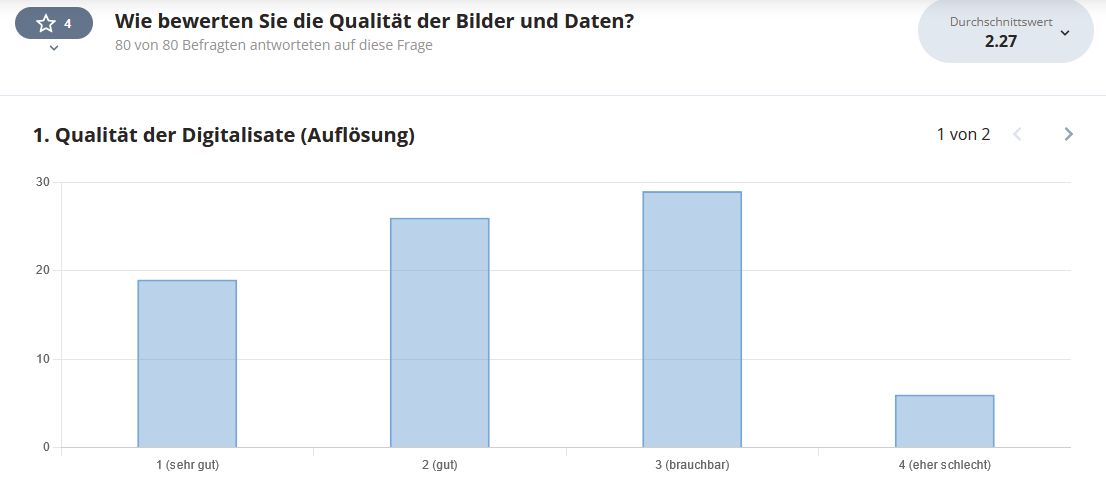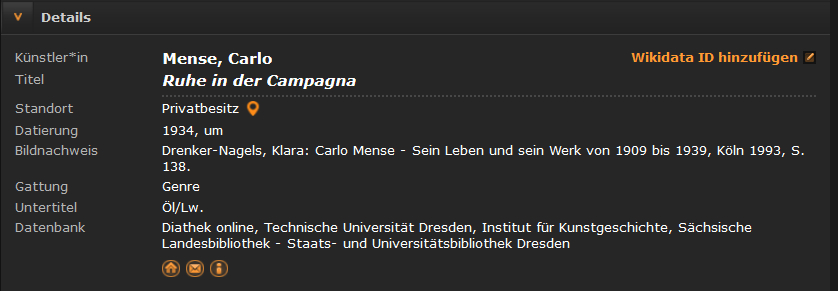Evaluation of the prometheus survey 2023 - 2
The second part of the evaluation of our survey focuses on “image quality”. Regarding the question “How do you rate the quality of the images, the quality of the digital copies (resolution)” on the scale “very good – good – usable – rather bad – very bad – no answer” we received the following answers:

We rougly clustered comments we have received on the topic:
„image quality“
- You can often find images with better image quality when searching Google images.
„differences in the image quality“
- Image quality very, extremely different, varies greatly – from very good to very bad, some very good, others not usable. (several comments) – Quality of the artwork varies greatly across multiple offerings of the same image. The question remains as to which image is closest to the original.
- A “sometime like this, sometimes like that” would fit well here. The quality of the images sometimes differs significantly. No general judgment is possible. The differences are particularly noticeable in objects that exist in countless variations, but you also notice the fluctuations in quality in works that only exist once.
- Some of the images are scans from catalogs which unfortunately have poor quality.
- Often cropped incorrectly.
- The vast majority of images are razor-sharp (in this respect, they could be called very good rather than good). A few undercut this standard. If I ever come across one of these, I usually report it too.
You have two different options in the image archive to share your comments about image quality.
(1) Share your findings directly with the source image databases. Under “details” for the image you will find information about the image database and three icons. By clicking on the middle icon you can “send an email to the person responsible for the database”.

(2)You can also use our rating function to assess the quality of the images.
These ratings influence the ranking when displaying the relevant search results. In addition, the ratings and the number of ratings are sorting options that you can select for displaying your search results list.
Another theme of your comments are the
„differences in color, brightness“
- quality varies greatly and I don’t have a reference model (color wedge) to judge whether the colors are correct.
- sometimes there are differences in the color representation of the same painting and the big guesswork begins as to which one is closest to the original.
- resolution is very different, color calibration of different versions is sometimes so different it’s enough to drive one to despair.
- some of the same works in different chromaticity; makes it difficult to make out the original color.
- There are digital copies of old slides with the rot disease, there are very good ones, especially by large museums. It is a matter of luck.
- Overall, the images are sometimes of very poor quality, especially when it comes to color accuracy.
- The older digital representations are sometimes very poor and vary enormously in terms of color. Some of these are not good photographs of book illustrations.
- The color isn’t always there either.
- The same work of art is sometimes shown lighter or darker. Here you have to do additional research to find out which one is the right one.
Fabian Felder from the University of Basel has tackled this issue in his article „A rustle in the pixel forest! Or could it be a little less yellow?“ and concludes as soon as image archives access already existing heterogeneous image databases the results are inconsistent in terms of quality especially in terms of color.
We have been aware of this problem of different colors in one and the same work from the very beginning (for over 20 years), as Lisa Dieckmann elucidates in her lecture (German only) „Mona Lisa’s sisters – on dealing with redundancies, image quality and heterogeneous metadata“ .
She presents mechanisms with which redundancies in search results can be structured in prometheus and gives an example of the advantage of redundancies: when they open up opportunities for critical reflection on images.
We will be working on additional filter and display options to deal with the mass of images in a workshop with some imaging institutions in November.








